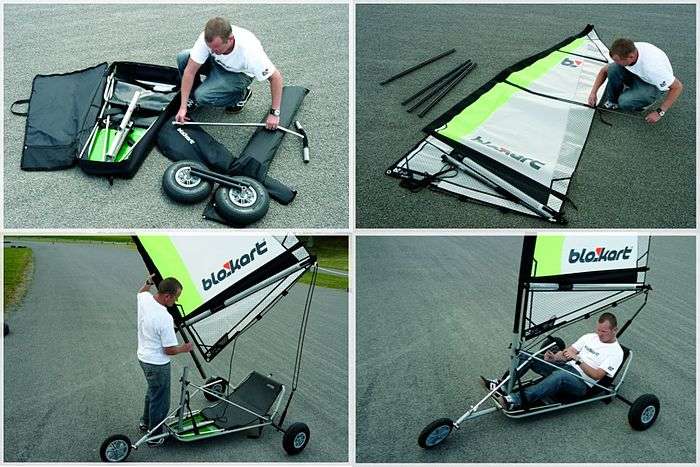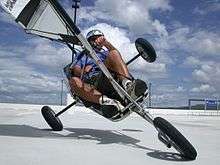Blokart
A blokart is a type of compact land yacht manufactured by the New Zealand-based company Blokart International Ltd.[1]
Due to their small size and maneuverability, blokarts are able to be sailed in small urban areas. They can be quickly disassembled and packed into a carry-bag giving them a high degree of portability.
Blokarts have hand steering (unlike most other land yachts) and require few sail adjustments which make them particularly easy to learn to sail. They are used for leisure sailing on beaches in many parts of the world.
Blokart racing is developing as a competitive international sport, with organised racing including National Blokart Championships now being held in many countries around the world.

History
The blokart design was developed in 1999 by inventor Paul "Guru" Beckett in Papamoa, NZ.
An initial 10 blokarts built in early 2000 were later recalled from the market due to improvements made to the design.
The first commercial blokarts were manufactured by Blokart International Ltd in a purpose built factory in Papamoa, NZ in 2000. Since then the fundamental blokart design has remained virtually unchanged. By 2010, the total number of karts produced exceeded 10,000 with almost half the blokarts sold in Europe. Other countries where blokarting is becoming popular are NZ, Australia, USA and South Africa.

The basic blokart including wheels, mast and sail weighs only 29 kg and can be dismantled in a few minutes without tools, and all parts packed into a carry-case. The high degree of portability allows the blokart to be transported by car, or carried as luggage on a plane. Unlike many other landyachts the blokart is steered using the hands via a centrally mounted bar directly coupled to the front wheel. This, along with its compact size, makes the blokart highly maneuverable and able to be used in small urban areas such as carparks or tennis courts.
Wheels can be replaced with ice blades to allow the blokart to sail on ice. The first Blokart Ice World Championships were staged in Lithuania in 2010.
A side-car accessory or "Shadow" can be added to allow the blokart to carry a passenger. Blokarts can be joined head-to-tail together using a "Deuce" bar. Multiple blokarts can be joined in this way to create long trains.
Blokarts have four standard sail sizes, 2.0m, 3.0m, 4.0m and 5.5m, with sail size choice being dependent on wind strength and weight of the sailor, with heavier sailors requiring larger sails, and smaller sails being more efficient in stronger winds.
Speeds of more than 100 km/hr have been attained on land and up to 130 km/hr on ice. The current blokart land speed record of 103.4 km/hr (64.4 mph) was set by Mark Walters at Red Lake, Arizona on 25 May 2012.
Adventure
In 2007 a group of 11 international adventurers crossed the Gobi Desert on blokarts. This journey was a project from the mind of the French enthusiast Chrisophe Gombert (France) who travelled across the steppes in 2006 with the Mongol guide and friend Batzorig preparing the social, cultural and sport raid for next year.
Racing
Blokart racing is a new but fast growing sport administered by the International Blokart Racing Association (IBRA) who sanction events and set the international racing rules.[2]

Although Blokarts meet the qualification standard for mini-yachts under the FISLY regulations, they are generally sailed in separate regattas organised under the IBRA rules. The lack of changes to the Blokart design from very early days has allowed a "one design" standard to be enforced, and subsequently Blokart racing has spread rapidly throughout the world. National and regional championships are now being contested annually in numerous countries including: USA, Australia, NZ, Britain, Spain, Belgium, France, Denmark, Sweden, Germany, Lithuania and the Netherlands
Blokart World Championships have been held biennially since the inaugural event at the home of Blokart in Papamoa, NZ in 2008. The 2010 championships was held in Ostend, Belgium. The 2012 event was staged on the dry lake bed at Ivanpah, California, with an attendance in excess of 150 Blokarts. The location for the 2014 event was Lake Walyungup, a dry lake bend near Perth in Western Australia. In 2016, the world championships will return to Ivanpah, California.
The 2013 European Championships were held in the UK at Weston Super Mare from September the 20th to 22nd; over 100 Blokarts took part.
Setup
Racing differs to other land yacht racing which typically has stationary starts and race across the wind on beaches. It has more in common with water based sailing with 2-3 minute dial-up starts and windward/leeward courses. Racing is held on purpose built tracks, airport runways, parking areas as well as beaches and dry lake beds.
The hand steering allows people with lower-limb disabilities to compete with able-bodied pilots.
Sail selection for racing is dependent on pilot weight and the sail course. Heavier pilots require larger sails. For tighter courses generally a larger sail size is required to provide the additional acceleration required. For straighter and more open courses a smaller sail provides less drag and therefore greater maximum speed.
Classifications
Blokarts are raced in two classes – production and performance. The production class is based on the basic blokart design. In the performance class additional parts from the manufacturer are allowed such as carbon fibre mast sections and an aerodynamic shell, adjustable downhaul and modification of the sail battens to alter the shape of the sail. New Blokart components must be available on the open market for more than 3 months before they are sanctioned by IBRA.
Depending on number of entries at events Blokart Classes are further broken down into weight divisions determined by the body-weight of the racer. For the blokart world championships the 4 following divisions have been defined:
- Lightweight Division: Less than 70 kg
- Middleweight: From 70 kg to less than 82.5 kg
- Heavyweight: From 82.5 kg to less than 95 kg
- Super Heavyweight: 95 kg and greater
There is generally no differentiation of blokart racers on the basis of age or gender.
Locations
Blokarting can be done on virtually any open area larger than the size of a tennis court. Beaches provide an ideal venue subject to tides, wind direction and density of people.

Some of the most well used areas for blokarting are listed below.
New Zealand
- 90 Mile and Tokerau Beaches in the far north
- Muriwai, Kariotahi, Orewa and other west coast beaches in Auckland
- Ardmore Airport - home of the Auckland Blokart Club.
- Blokart Heaven - a purpose built Blokart track in Papamoa
- Ohakea Airforce Base
- Foxton Beach and Sanson Track in the Manawatu
- Waitere & Waikanae Beaches near Wellington
- Vortex Wind Karting Track and Rabbit Island near Nelson
- Velocity Karts - a purpose built track in Christchurch
- Wigram Airfield - home of the Canterbury Blokart Club
- Oreti Beach near Invercargill
Australia
- Lake Lefroy, Lake Walyungup and Caron Dam Bitumen(Perenjori) in Western Australia
- Lake Gillies in South Australia
- Yeppoon and Buschia Beaches in Queensland
- Wangaratta [HQ for the North East Windsport Club], Olivers Lake and the Gippsland Beaches in Victoria
United States
- Ivanpah Lake near Las Vegas
- Red Lake (Arizona – New Mexico)
- New Jersey Beaches - Brigantine, Wildwood ( off season)
- Musselman Honda Circuit Arizona
Europe
- Blokart CPH, Amager Strandpark, Copenhagen, Denmark
- Rømø Island, Denmark
- IJmuiden beach near Amsterdam, Netherlands
- Nida, Lithuania
- Ostend and Zeedijk Beaches in Belgium
- Zaragoza, Spain
- Land Sailing Tarifa, Spain
- Son Vent blokart track, Binissalem, Mallorca, Spain
- Villaumbrales Blokart Racing, Palencia, Spain
- Saint Pierre Quiberon (Blokart Center), Saint Malo, France
- La Franqui beach, France
- blokart - LandSailing Austria - Vienna
United Kingdom
- Map of UK Blokart sailing venues
- Cefn Sidan Beach in Wales
- Weston Super Mare in Somerset
Clubs
Australia:
- Brisbane Blokart Club
- Central Queensland Blokart Club
- Capricornia Blokart Club http://www.sandyachting.info
- Hunter Valley Blokart Club
- Melbourne Blokart Club
- NSW Blokart Club
- Perth Blokart Club
- Victorian Blokart Association
- Wangaratta, Victoria - North East Windsport Club
New Zealand:
- Auckland Blokart Club
- Bay Blokart Club
- Hawkes Bay Blokart Club
- Canterbury Blokart Club
- Capital Blokart Club
- Manuwatu Blokart Club
- Top Of The South (Nelson) Blokart Club
United Kingdom:
United States
See also
- Ice yachting
- Kite buggying
- Kite landboarding
- Land windsurfing
- Whike sailing cycle
- Wind-powered land vehicle
References
External links
| Wikimedia Commons has media related to Land sailing. |
- The BLSA UK governing body for Blokart Sailing and Land Speedsailing
- Carmarthenshire Land Sailing Club (UK) - land sailing club sailing at the Cefn Sidan (Pembrey) and also Pendine beaches
- NALSA (USA) - the North American Land Sailing Association
- SeaBreeze Blokart Forum, "Australian Land Sailing Forum" section for Blokarts.
- New Zealand Blokart Association - Includes the IRBA rule book.
- Blokart Heaven - A purpose built land yacht track in Papamoa New Zealand.
- Blokartersuk.com (UK)
- Class Action Racing US blokart website.
- Blokarten.info (Dutch) - Dutch information portal for blokarting.